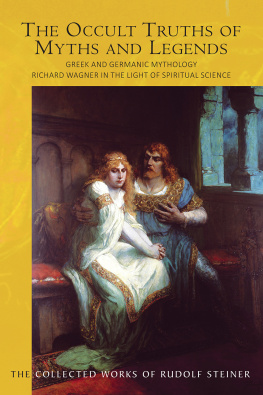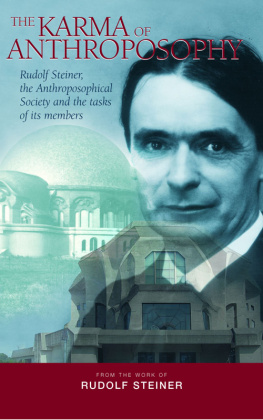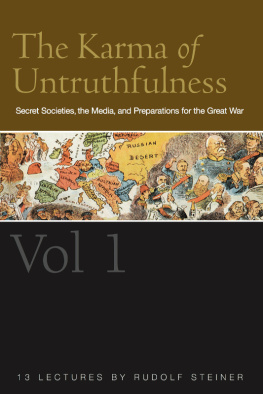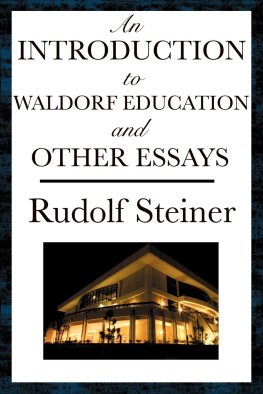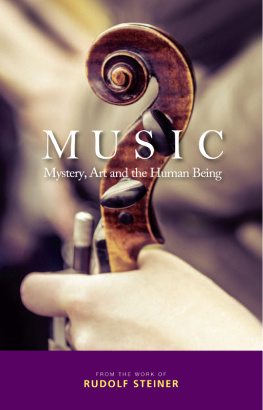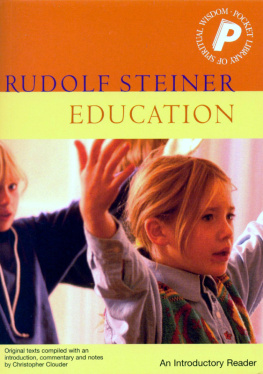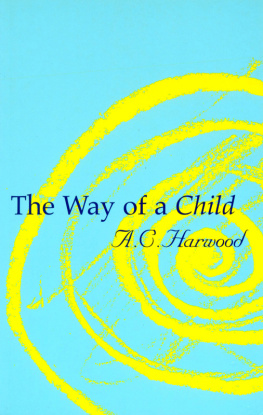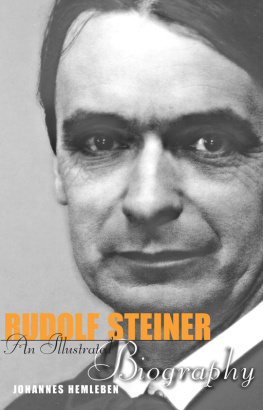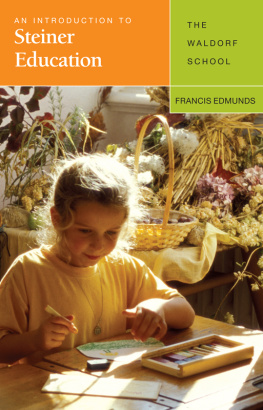THE CHILDS
CHANGING CONSCIOUSNESS
As the Basis of Pedagogical Practice
[XVI]
FOUNDATIONS OF WALDORF EDUCATION
R U D O L F S T E I N E R
The Childs
Changing Consciousness
As the Basis of Pedagogical Practice
The publisher wishes to acknowledge the inspiration and support of Connie and Robert Dulaney
In the collected edition of Rudolf Steiners works in German, the volume containing these texts is Die Pdagogische Praxis vom Gesichtspunkte geisteswissenschaftlicher Menschenerkenntnis (vol. 306), published by Rudolf Steiner Verlag, Dornach, Switzerland, 1982. The lectures were translated by Roland Everett and edited by Rhona Everett; they have been revised for this edition.
Published by Anthroposophic Press
Copyright 1996 by Anthroposophic Press
Library of Congress Cataloging-in-Publication Data to come
Steiner, Rudolf, 1861-1925
[Padagogische Praxis vom Gesichtspunkte geisteswissenschaftlicher Menschenerkenntnis. English]
The childs changing consciousness as the basis of pedagogical practice / Rudolf Steiner.
p. cm.(Foundations of Waldorf education : 16)
Translated from the German by Roland Everett and edited by Rhona EverettT.p. verso.
Includes bibliographical references and index.
ISBN 0-88010-410-4
1. EducationPhilosophy. 2. Waldorf method of education. 3. Child development. 4. Anthroposophy. I. Title. II. Series.
LB775.S7P3313 1996
370'.1dc20 96-33210
All rights reserved. No part of this book may be reproduced in any form without the written permission of the publishers, except for brief quotations embodied in critical articles and reviews.
Printed in the United States of America
CONTENTS
Lecture One
A PRIL 15, 1923
What must happen for education to receive a new heart again? The intellectual age has reached a one-sided view of the human being. Its findings are based upon what becomes evident when the spiritual and some of the soul forces are left out of account. Many elements of an unreal soul constitution have crept into the present-day scientific viewpoint of the world. In order to reach the human being, living ideas are needed. In educational practice the whole life span of the human being needs to be considered.
Lecture Two
A PRIL 16, 1923
Knowledge of the growing childThe first three faculties: walking, speaking, and thinking. In coming to terms with statics and dynamics, the weaving of destiny is hidden. From its environment the child absorbs the soul element of its surroundings. Through thinking it takes hold of outer nature.
Lecture Three
A PRIL 17, 1923
Imitation as a natural law. Religious devotion toward the surrounding world. The widening of the horizon through the childs walking, speaking and first thinking. Approaching the artistic element through the medium of language. The child needs a pictorial, and not a logical approach. During the second life period acceptance of authority becomes a natural law. With the change of teeth memory begins to develop out of the childs ensouled life of habit. The interweaving of breathing and blood-circulation within the rhythmic system during the ninth and tenth years, and, through it, the childs taking hold of the musical forces. Puberty. The nature of the rhythmic system.
Lecture Four
A PRIL 18, 1923
The importance of play during the stage of imitation. The transformation of play into work. Writing out of the activity of painting and drawing. Learning to read. Speech. Vowels and consonants. The main periods of life and the ninth year in particular. Ego and the surrounding world. First nature study. The plant world from the earthly point of view. The animal world as an unfolded or spread out human being.
Lecture Five
A PRIL 19, 1923
The childs life of feeling between the seventh and fourteenth years. The nature of authority. The childs life of will. The childs experience of the pictorial element before and after the ninth year. The artistic element in lessons. The different characteristics of the human members during the course of life. After the twelfth year the sense for causality begins to develop. The child is now ready for lessons on mineralogy, physics, and a causal interpretation of history. The harmful effects of premature judging. The crisis around the ninth year. Color perspective and flexibility of soul. Learning to read. The transition of knowledge into faculties.
Lecture Six
A PRIL 20, 1923
The relationship of the individual to the body social. The three fundamental virtues: gratitude, love, and a sense of duty, and their development. The need to introduce an element of soul breathing in the lessons. Seriousness and humor. An all embracing attitude to life should pervade the teachers soul and spirit. Education and healing. Education is self-education. The teacher needs to cultivate unselfishness. Education as a social deed. Institutions are of little significance in social development. The two guiding principles for working in the social sphere.
Lecture Seven
A PRIL 21, 1923
The need to compromise in coping with the demands of modern life, especially after the twelfth year. Through the sense of gratitude and the ability to love, the third fundamental virtue is unfolded, namely the sense of duty. After the twelfth year, and especially after puberty, education must enter practical activities: lessons in knitting, sewing, weaving, spinning, and bookbinding for both boys and girls. Introduction of simple mechanical and chemical processes used in technology and the ensuing permeation of the physical body by soul and spiritual forces. Shortage of available lesson time due to pressure of exam work. The tragedy of materialism.
Lecture Eight
A PRIL 22, 1923
Running a school on the principles presented in the course. Equal consideration must be given to body, soul, and spirit. The hygienic and therapeutic aspect of education. The interweaving and interaction of the three main systems: nerves and senses, the rhythmic system, nutrition and movement. Childrens illnesses during the first seven-year period. The second seven-year period is the healthiest, because the rhythmic system radiates out into the childs entire organism and the rhythmic system never tires. Faculty meetings as the lifeblood of the school. The school doctor. How to treat the various temperaments. Each detail within the entire school life must reflect the spirit reigning throughout the school. Block periods in Main Lessons. Language lessons. Gymnastics and eurythmy. The entire human organism is oriented towards the forces of music. Waldorf education as an education for all humankind.
FOREWORD
Early in 1919 Rudolf Steiner was asked by the director of the Waldorf Astoria Tobacco Company in Stuttgart, Germany, to give lectures to the factory workers on the question of what new social impulses are necessary in the modern world. Responding to the lectures, the factory workers requested of Rudolf Steiner that he further help them in developing an education for their own children based on the knowledge of the human being and of society that he had opened up for them. By the end of April, that same spring, the decision had been made to establish a new school for the workers children, the first Waldorf school.
Today, the Waldorf school movement, as it is still known (or the Rudolf Steiner school movement, as it is also called), is one of the largest, and perhaps the fastest growing, independent school movements in the world. In 1984 there were over 300 schools worldwide, throughout Europe, in the United States, Canada, South America, South Africa, Australia, and New Zealand. By 1995, the seventy-fifth anniversary of the Waldorf movement, there were over 600 schools in almost forty countries. Based on a comprehensive and integrated understanding of the human being, a detailed account of child development, and with a curriculum and teaching practice that seek the unity of intellectual, emotional, and ethical development at every point, Waldorf education deserves the attention of everyone concerned with education and the human future.


